


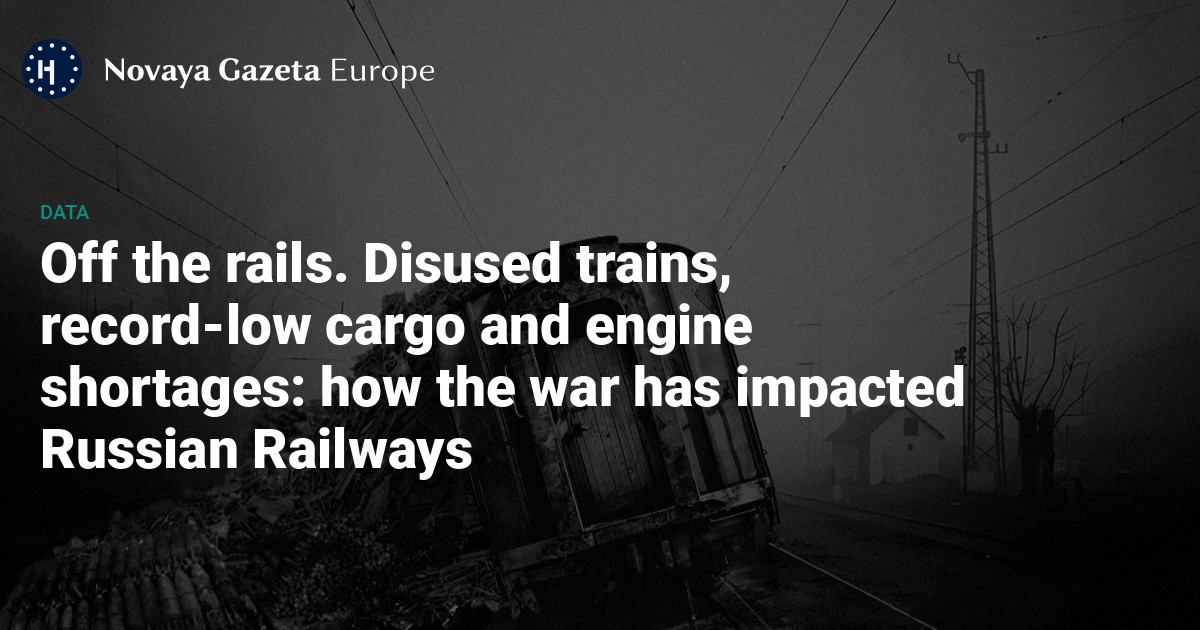
State-owned monopoly Russian Railways is at a crisis point, the company’s worst since the Great Recession almost two decades ago, with freight volumes at a record low due to the combined effects of Western sanctions and dwindling flows of agricultural goods and construction materials.
Nevertheless, Russia’s rail network is congested, not only with trains rushing to deliver military supplies urgently needed at the front, but with unused carriages. It also critically lacks both the personnel and locomotives required to keep the rail system running smoothly, and these problems only seem to be getting worse.
This matters not only because Russian Railways is one of Russia’s largest and richest state-owned enterprises, but because railway transport activity is also a bellwether for the wider economy — freight must be moved today in order for business to be done tomorrow. When rail traffic is disrupted, it usually signals that an industrial slowdown is imminent.
So what, then, can the dysfunction of Russia’s national rail system tell us about the health of the country’s economy in 2025? And will Russian Railways be able to get itself back on track any time soon?
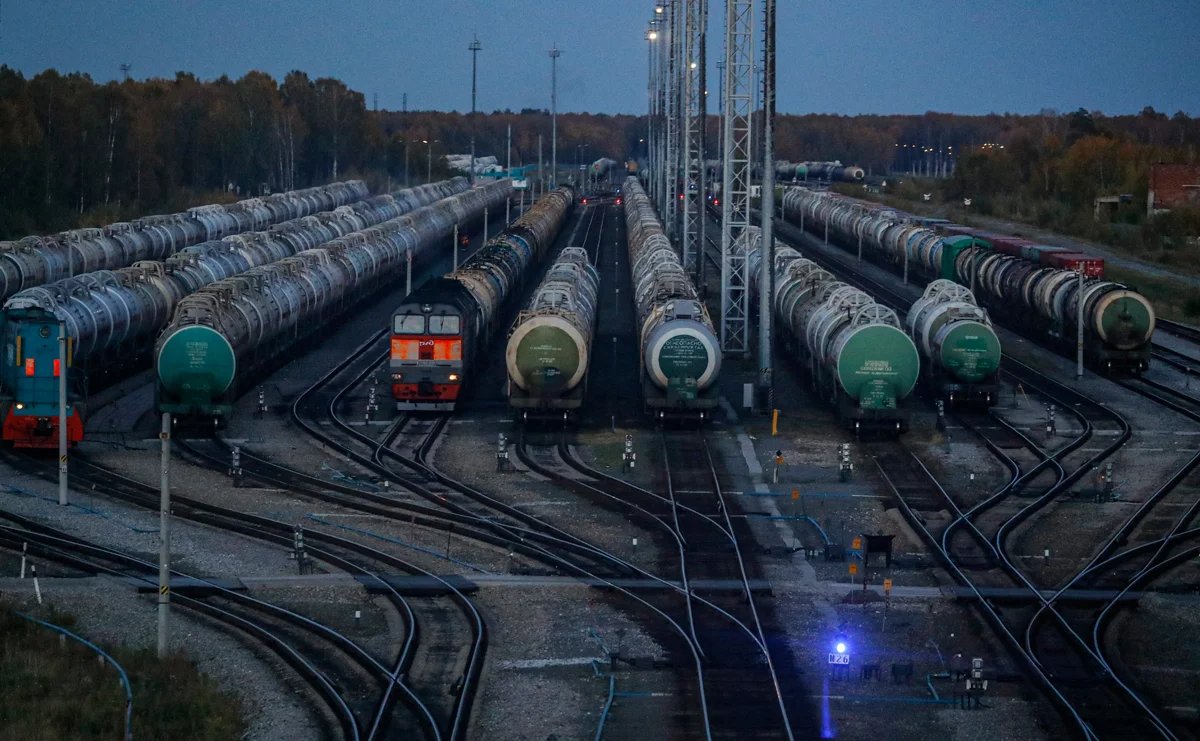
Tankers at a railway yard in Tobolsk, Tyumen region, Russia, 24 September 2012. Photo: Sergey Ilnitsky / EPA
The origins of the national rail service’s current crisis can be traced back to February 2022. Within the first 12 months of Russia’s invasion of Ukraine, transport flows in two key categories of goods had collapsed. Raw materials, such as timber, ferrous metals, ores and minerals, came under sanction by the West, while international demand for fertilisers — despite being unsanctioned — also fell significantly after Russia’s major banks were excluded from the SWIFT international payment system.
As the war entered its second year, Russian Railways appeared to be surviving financially, although clear signs of strain had begun to appear. The national rail service had seen total freight transports fall 4% in 2022, marking the worst-ever drop-off since the global financial crisis hit Russia’s economy in 2008. However, transport flows stabilised in 2023 as export numbers for non-sanctioned goods recovered. In particular, fertiliser exports rose as global buyers moved quickly to hedge against possible sanctions, while a strong wheat harvest kept Russia’s grain flowing steadily to foreign markets, where demand soared amid low prices.
All totalled, shipments have now fallen for 20 consecutive months, and the trend is accelerating.
But in 2024, the downturn returned, with freight volumes plummeting by 4% once again, and the situation has only worsened so far this year. Grain transportation, one of the biggest drivers of growth in 2023, dropped sharply last year, as did ferrous metal — usually a reliable category of transport — for the first time. The decrease in traffic is partially due to the decline in both steel smelting and exports, which have fallen for 11 months prior to early 2025, primarily due to sanctions. But it also reflects the struggling Russian construction industry, which usually consumes large amounts of steel. In 2025, the number of new residential construction projects has already declined by a quarter, and the government expects the trend to worsen. That means Russian Railways is hauling fewer metals, construction materials, and cement, all of which hurts transport figures.
All totalled, shipments have now fallen for 20 consecutive months, and the trend is accelerating. Last year, freight volumes dropped by just over 4%, matching a post-Soviet record. But they have continued to fall by more than 7% in the first five months of 2025 alone, nearly equalling the total decline since the war began, and painting a bleak picture for the future.
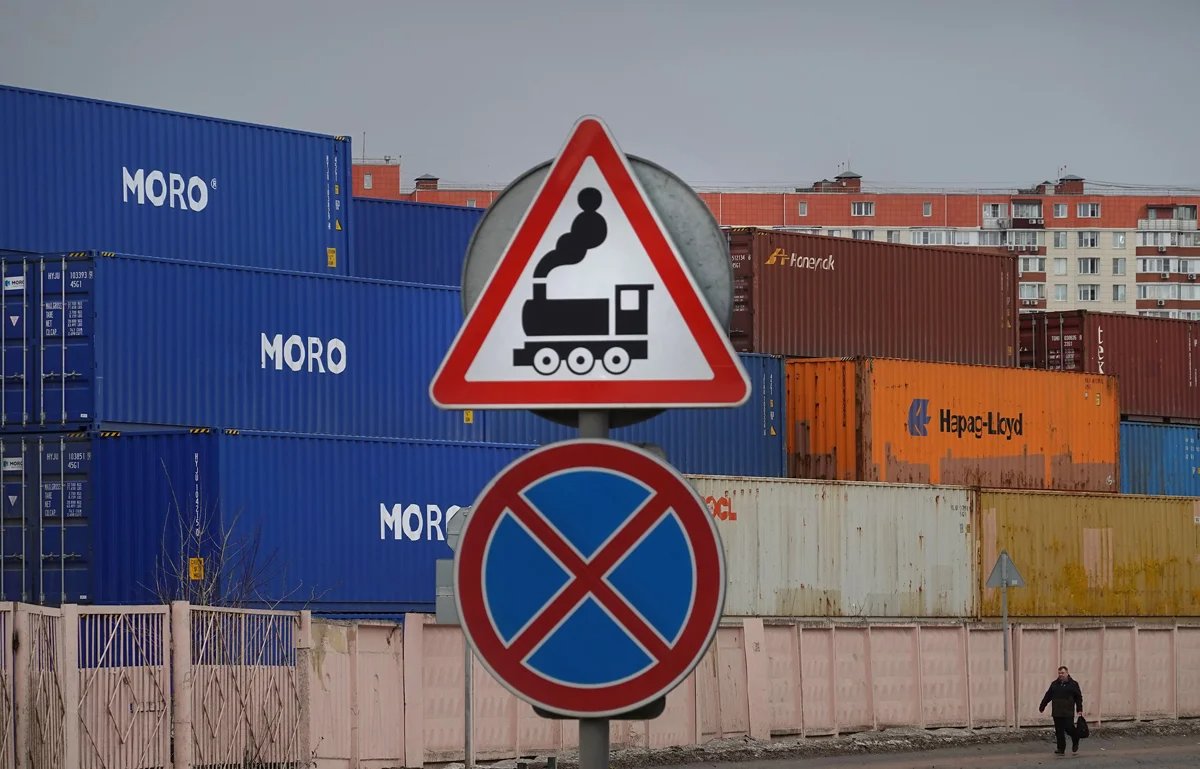
Photo: Maxim Shipenkov / EPA
There is one transportation item, however, that grew steadily from 2022 to 2024. Labelled vaguely as “Other goods, including in containers,” Russian Railways does not specify what this category actually entails in its official data, but transport analysts generally believe it refers to military cargo, from ammunition and equipment to materials used in arms production.
In fact, the prioritisation of military freight is likely one of the most important reasons for the decline in other categories of haulage. But, as the Russian macroeconomic analysis Telegram channel MMI put it, it is “a factor that is not customarily spoken about”.
North Korean shells are being transported in containers from east to west.
Given the state’s prioritisation of all things military, it’s no surprise that civilian freight volumes have fallen, military expert Yury Fedorov told Novaya Gazeta Europe. “Clearly, some of the ‘other goods’ very likely relate to military production — there may be ammunition in the containers. North Korean shells are being transported in containers from east to west. Trains with tanks and artillery are travelling from factories and repair plants to the front and from the front back to the enterprises that repair them.”
The exact volume of weapons and ammunition shipments, as well as raw materials for their manufacture to military factories, has, of course, not been disclosed by Russian Railways.
But Russian Railways’ falling freight volumes cannot be explained by the uptick in “other goods”; these figures have also fallen so far in 2025, despite the Russian military’s widely anticipated summer offensive in Ukraine.
The problem would appear to lie deeper and likely stems from the structure of Russia’s rail network, in which few sections operate independently, so when problems arise in one area, they quickly spread to the others.
The Western parts of the rail network, on the other hand, now primarily transport military supplies, with little in the way of exports since the imposition of sanctions in 2022.
This can happen incrementally due to several factors. Freight traffic to the southern ports of Novorossiysk and Taman has declined, for example, partly because frequent bombings have led to their closure, resulting in fewer ships docking and a sharp drop in dry cargo shipments by rail. The Western parts of the rail network, on the other hand, now primarily transport military supplies, with little in the way of exports since the imposition of sanctions in 2022.
Western Russia had continued to export coal, which accounts for one-third of Russian Railways’ overall cargo volumes, but those exports have fallen since last year’s coal price collapse and the recent appreciation of the ruble made it unprofitable for Russian Railways to transport the cargo. The same phenomenon has also occurred in Russia’s Far East, according to Alexander Polikarpov, managing partner at Rollingstock Agency, a Russian consultancy specialising in rail logistics and infrastructure, which means that the company’s three key corridors to the global market are now more or less closed to coal exports.
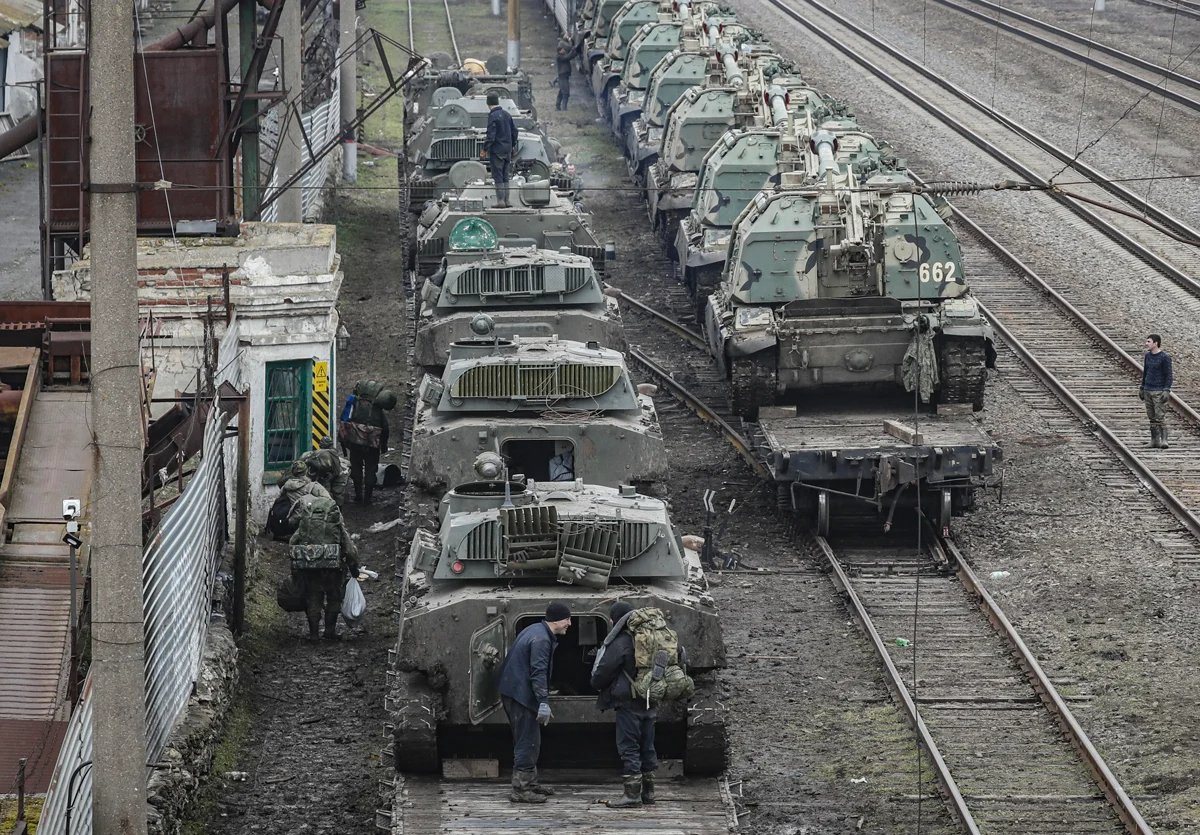
Russian servicemen and military equipment at a railway station in the Rostov region, Russia, 23 February 2022. Photo: EPA
Two additional problems explain why less freight is being transported. First, Russian Railways lacks sufficient staff due to the war, which has left Russia’s economy facing a significant personnel shortage. Some workers have been mobilised and many others have enlisted after being offered significant financial incentives, while many more have simply left the country. According to the company’s own figures, Russian Railways currently has a shortfall of approximately 2,500 engineers and around 3,000 locomotive crews, resulting in it being unable to run some 200 trains each day.
Second, locomotives are in short supply as well. In fact, according to a survey conducted last year, one-third of Russian industrial enterprises with non-public tracks lack locomotive engines, although Russian Railways has denied that the problem exists. In January–April 2025, the production of mainline electric and diesel locomotives in Russia fell by 13% and 6%, respectively.
By contrast, there are plenty of carriages, but this could be causing more harm than good. Shortages of workers and locomotives are causing bottlenecks, as carriages remain stationary for weeks at a time, often blocking traffic. According to internal data collected by Russian Railways, 300,000 wagons had accumulated on the network as of March 2025, almost a fifth of the rail service’s entire fleet.
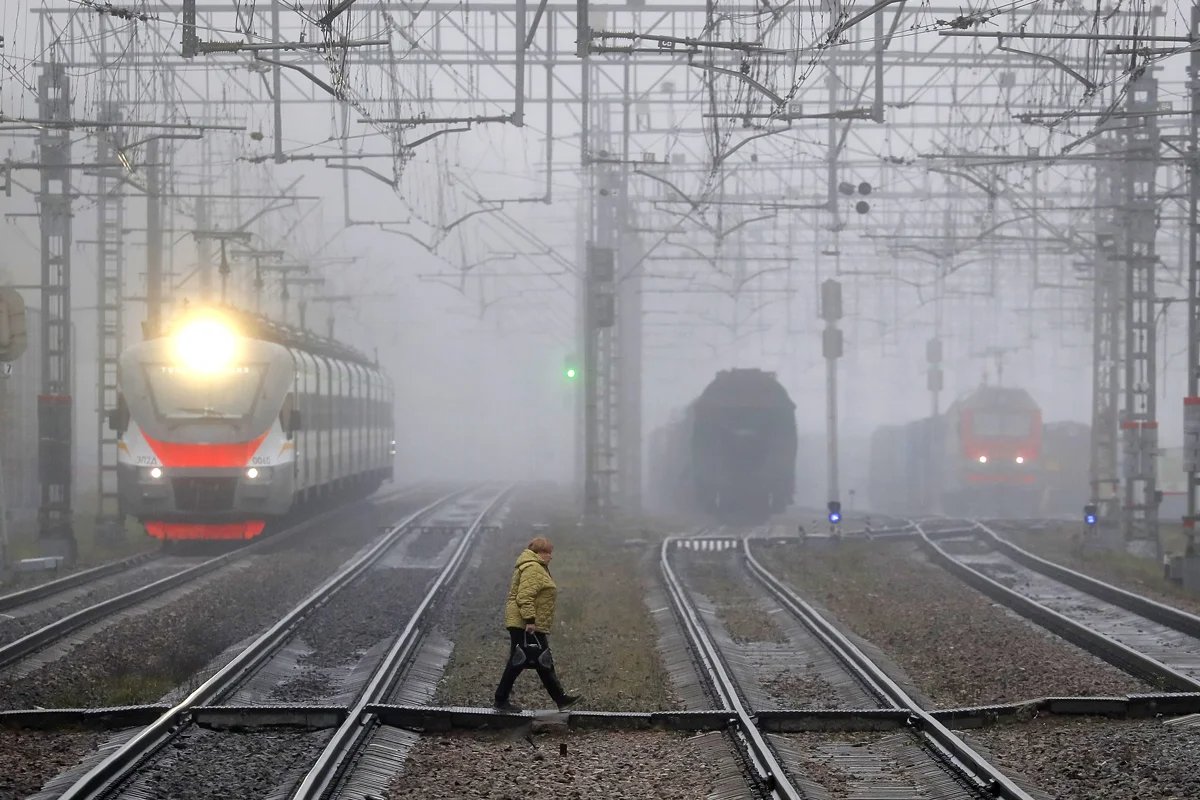
Photo: Maxim Shipenkov / EPA
According to estimates made by Russian Railways, the company will need to purchase approximately 1,000 electric and diesel locomotives annually until 2035, as half of its 20,000-strong fleet of locomotives will require replacement by then. At current prices, therefore, it needs to be spending at least 220 billion rubles every year (€2.4 billion) to meet this vital goal.
However, despite the fact that its basic tariff rate for transporting goods has been increased over one and a half times, and passenger transportation profits have continued to grow since the start of the war in Ukraine, the operator’s net total profits fell threefold in 2024 compared to the previous year. The company’s main problem is that it earns relatively little while simultaneously borrowing and spending a lot — though not on the infrastructural improvements it needs.
Last year, for example, of the 1.5 trillion rubles (€16.47 billion) Russian Railways allocated for investments, approximately 200 billion (€2.2 billion) was spent buying a skyscraper in the prestigious Moscow-City commercial development to house new office space.
Due to this purchase and a drop in profits from the transportation of freight and cargo, projections show that Russian Railways will have to cut 40% — some 600 billion rubles (€6.59 billion) — of its investment budget this year in order to stay afloat, despite its pressing need for more engineers and locomotives.
In some ways, Russian Railways is simply facing the consequences of economic stagnation, which began in late 2024 and is expected to continue until at least 2027. But even if the war in Ukraine ends, sanctions are lifted, and exports to the West resume, it would take years for the state rail monopoly to recover from its deepening crisis.
“Even in the most optimistic scenario of an improvement in the geopolitical situation and the prompt end to the [war in Ukraine], a real effect on rail transportation will still be noticeable for 1.5–2 years,” Rollingstock’s Polikarpov writes.
This year, the downturn in construction materials is expected to be the most significant drag on overall freight volumes. Coal transport may recover following a disastrous 2024, which, along with fertiliser (which is still not subject to Western sanctions) and container shipments, will drive some growth. But that won’t be enough to compensate for lost freight flows, especially not to the extent needed to keep the system afloat.
Russian Railways needs cash to buy more locomotives, hire more workers, and invest in basic infrastructure maintenance.
To do that, Russian Railways needs cash — to buy more locomotives, hire more workers, and invest in basic infrastructure maintenance. With profits dwindling and debt rising, the company may have only one option left: to persuade the government once again to raise tariffs above the rate of inflation, as it has done every year of the war so far.
Yet, even in this strategy there is a paradox. After raising its tariffs, Russian Railways often resorts to offering steep discounts to cargo customers to ensure its trains don’t run empty, according to analysts from Russian Telegram channel N.Trans Lab, which covers the transport industry with a focus on logistics.
If this practice continues, the experts warn, Russian Railways could face an even worse scenario and find itself forced to dismantle parts of its rail network entirely — lines for which there is no longer sufficient demand, and which have become too costly to sustain, both for Russian Railways itself and for the economy as a whole.
The Russian government has banned independent media. We were forced to leave our country in order to keep doing our job, telling our readers about what is going on Russia, Ukraine and Europe.
We will continue fighting against warfare and dictatorship. We believe that freedom of speech is the most efficient antidote against tyranny. Support us financially to help us fight for peace and freedom.
By clicking the Support button, you agree to the processing of your personal data.
To cancel a regular donation, please write to [email protected]
VPNovaya
Help Russians and Belarusians Access the Truth
